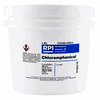
ALLMEDTECH.COM
ALLMEDTECH.COM
MEDICAL, SURGICAL, DENTAL,
PHARMACEUTICALS , OBGYN,
VETERINARY & PET SUPPLIES,
DIAGNOSTIC LAB, COSMETICS,
VACCINES , INJECTABLES , IV ,
GENERIC & OTC MEDICATIONS ,
PHARMACY'S AND MED-SPORT
SUPPLIES & EQUIPMENTS
TOLL FREE: 1-800-939-6944
Chloramphenicol,
750 Grams
RPI-C61000-750.0
750 Grams
RPI-C61000-750.0
Product Description

Chloramphenicol,
750 Grams
RPI-C61000-750.0
Research or further manufacturing use only, not for food or drug use.
Molecular Weight: 323.1
Chemical Formula: C11H12Cl2N2O5
Solubility: Ethanol, Methanol and Slightly Soluble in Water
Storage Temperature: Room Temperature
Chloramphenicol is an antibiotic that belongs to the class of antibiotics known as the phenicols. Chloramphenicol is effective against a broad range of Gram-positive and Gram-negative bacteria.
In the field of microbiology and cell culture, Chloramphenicol is commonly used as a selective agent. It inhibits bacterial protein synthesis by targeting the 50S ribosomal subunit, preventing the growth of bacteria.
Researchers add Chloramphenicol to growth media or solutions to selectively allow the growth of cells or organisms that have been genetically modified to carry a resistance gene for Chloramphenicol. This gene allows the cells to survive and propagate in the presence of the antibiotic, while non-transformed cells are inhibited.
Chloramphenicol also finds applications in molecular biology and genetic engineering research. It can be used to maintain and propagate plasmids or other vectors that contain the Chloramphenicol resistance gene.
Additionally, it is employed in studies involving gene expression and protein synthesis.
750 Grams
RPI-C61000-750.0
Research or further manufacturing use only, not for food or drug use.
Molecular Weight: 323.1
Chemical Formula: C11H12Cl2N2O5
Solubility: Ethanol, Methanol and Slightly Soluble in Water
Storage Temperature: Room Temperature
Chloramphenicol is an antibiotic that belongs to the class of antibiotics known as the phenicols. Chloramphenicol is effective against a broad range of Gram-positive and Gram-negative bacteria.
In the field of microbiology and cell culture, Chloramphenicol is commonly used as a selective agent. It inhibits bacterial protein synthesis by targeting the 50S ribosomal subunit, preventing the growth of bacteria.
Researchers add Chloramphenicol to growth media or solutions to selectively allow the growth of cells or organisms that have been genetically modified to carry a resistance gene for Chloramphenicol. This gene allows the cells to survive and propagate in the presence of the antibiotic, while non-transformed cells are inhibited.
Chloramphenicol also finds applications in molecular biology and genetic engineering research. It can be used to maintain and propagate plasmids or other vectors that contain the Chloramphenicol resistance gene.
Additionally, it is employed in studies involving gene expression and protein synthesis.




